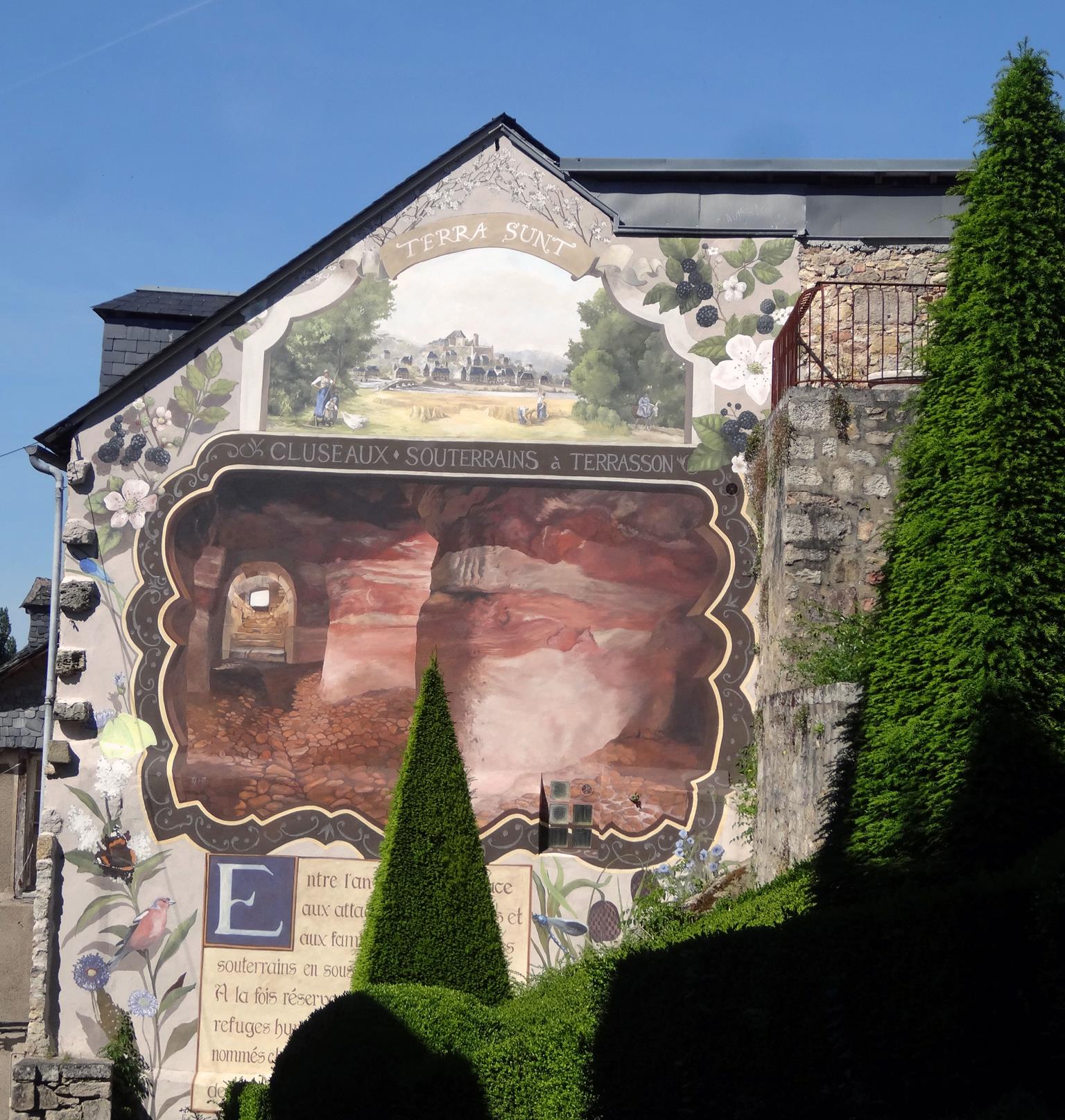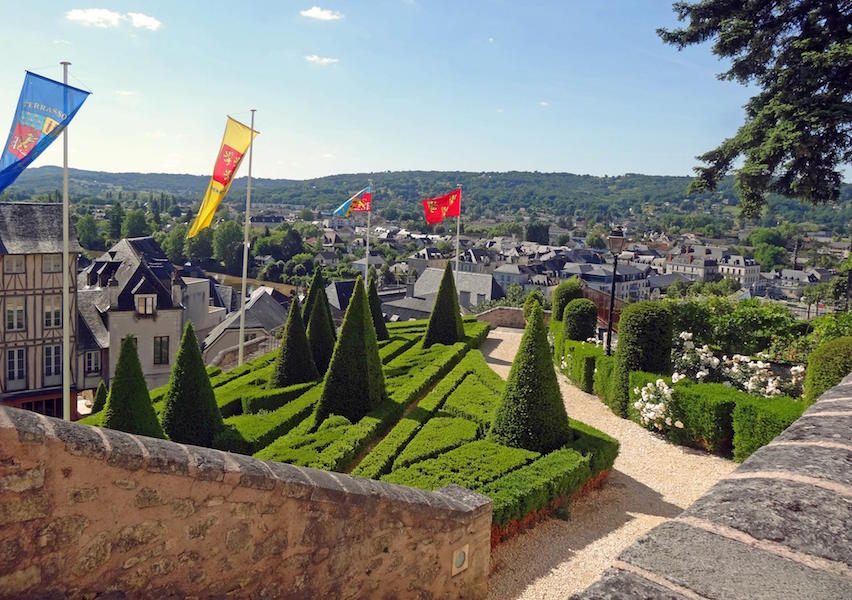There are a lot of formal gardens in France, especially at chateaux, and in the last three months I’ve seen a lot of them! So the prospect of visiting a contemporary garden in an historic town in Perigord Noir captured my imagination. Les Jardins de l’Imaginaire, in the very pretty if ‘business-like’ town of Terrasson, allured me even more because of the involvement of an internationally acclaimed landscape architect – and its website promise of:
“a garden made to inspire dreams”.

Les Jardins de l’Imaginaire (Gardens of the Imaginary) ticket office and boutique is housed in the 19thC Joan of Arc Castle with its classic French garden of clipped box and yew plants

View of Terrasson from Les Jardins de l’Imaginaire
Set on a sloping 6 hectare site with views over the township and the Vézère river, there are 13 ‘scenes’ now enlivening an area that was a terraced park. The gently sloping path up to the garden entrance is modern and sleek, at first straight with paving and walls of stone, then curved to an elevated steel walkway. It is in stark contrast to the characterful golden-warm stone used to build almost everything in this region, but a channel of running water and oodles of greenery neutralise this austerity.

Looking back down the entrance path towards the town and ticket office. The path and clipped shrubs are all sculpted by human hands. Themes of the gardens begin here!

Curves and undulations appear in this section of the entrance walkway, with rounded shrubs and cloud trees and freer foliage forms of the canopy and ferns
Around the curve the overhanging branches ahead are inviting and once there, feel even better, as it’s quite a warm, sunny day. Much of the garden is shaded, and I’m fair-skinned – no wonder I like this place already! Our group of about 10 wait at the closed gates as visiting is by guided tour only, in French. Our guide explains the garden was designed by landscape architect Kathryn Gustafson and architect Ian Ritchie. It came about in response to an international competition in the early 1990s when the mayor of Terrasson proposed the challenging idea of a new contemporary garden. His vision was to add culture and tourism to the heart of the town’s development.
I however read this on the English notes provided for non-French speakers, where I also learn the theme of the garden is ‘working with nature, not against it’, and
“the work is organised around six unchanging elements: vegetation, mineral, water, relationship with the wind, perspective and the path”.
There is much more detail about themes, but it is sounding to me like a design submission to get the gig, so I turn my attention to what’s around us and observe the ‘human’ straight lines versus the ‘wavy’ lines of nature, as intended.

Sacred Woodland has 1200 clipped buxus, with some of the evergreen shrubs planted below a grill in the path to rub your feet over for good luck
Passing through the gates the mood instantly changes. A thick tree canopy and a path bordered on one side by clipped upright straight hedges and on the other by broad rounded clipped buxus carpet the rising slope. The path leads us to an arbour draped in wisteria, hops, jasmine, hydrangea, and chocolate vine (Akebia kinata), which is visible from a way off and beckons you to walk under it. There is no alternative as the journey is controlled to follow one direction, one path, one guide – but I still didn’t think to look for another way. My mind impelled me to walk under the green canopy.

Green Tunnel, the structure covered with climbing plants and gabion wall provide the transition to the ‘imaginary world’
Exit the arbour and glistening suddenly in a ray of sunshine is a long gold ribbon weaving high amongst the tree trunks. It challenges my imagination – my heart skips a beat. I look around to see if anyone else feels this, and see my non-gardening partner trying to photograph the scene in the deeply-dappled light (tricky). He’s clearly quite mesmerised. Is the ribbon ‘helping us out of the ordinary into the world of dreams’? – my reaction feels like that. There’s an aura about this juxtaposition – the might of the tree trunks rising up with a molten-like serpentine ribbon meandering above our heads. Is this a stimulated primeval reaction – ‘snake’!? Our photos really don’t capture the effect. Probably because it is sensory; a place in which each ‘scene’ immerses you in being there and experiencing it. It’s nothing forced; we aren’t told this is possible or likely, it just happens.

Elementary Gardens, an evocation of medieval monastic gardens, here concentrating on the medicinal and decorative. Remnant black locust trees (Robinia pseudoacacia) with the pathway built around them

The golden ribbon winds through the trees, beneath grow ferns, pieris, azalea, rhododendron, hydrangea and camellia

There are seven varieties of maples here, including the tri-lobed Montpellier maple (Acer monspessulanum)
Continuing under the tree canopy and up the incline, we drift into the moss garden. “The moss-covered stone terraces are arranged such as vineyard rows would have been before the vines of France were decimated by phylloxera in 1863” (the Perigord region was subsequently planted with walnut trees). The Moss Terrace looks like it has been here for millennia – it seemed we’d chanced upon a secret undiscovered place, belying its tender age (created for the gardens opening in 1997).

Moss Terraces, dry-stone walls covered with moss are arranged in rows evoking typical hillside agriculture

The Greenhouse, which is symbolic rather than greenhouse, has a laminated glass roof built to simulate a lake reflecting the clouds, trees, foliage and colours of the sky. The roof looks more water-like in this photo than it appeared on the day. Ian Ritchie’s greenhouse has won various international awards for its design.

Open-air Theatre – the dark blue-grey colour of the benches creates a direct link to the slate roofing of the town. (This is the first view of the town since entering the garden.)

Viewpoint over Terrasson

The Perspectives, the ‘waves’ down the slope create a visual staircase from the gardens to the town. Plantings are blue catnip and white roses (not in flower). Ten weathervanes descend the slope towards the town, each with a bell playing a different tune, depending on the wind, to echo the church bell.
Moving along, we follow a gracefully curving path downslope to the water gardens. Imagine voluminous, invigorating fountain jets spurting up from the grassy slope, and a court with water spurts that’s just plain fun! They spray to varying heights and directions, and the cooling mist is tingly. Now we’re out in the full sun, it feels fantastic. The more difficult, but so delightful, thing to describe is the sound. It is quite lyrical. The combination of the sprays, splashes and bursts, and the running water of the channels is playful and simultaneously soothing.

Water-jet Forest, inspired by ‘the form of the Lombardy poplars’.

Fountain shooting up from the grass is one of 120 water jets

The imaginative water garden

Beginning of the long straight water channel. The paving in the photo looks a little dull, but in reality is an effective subtle backdrop for the water play and is not imposing for such a large expanse.

View to the town church from the water garden surrounded by richly planted garden beds.

The water flows and gushes over stone that is stepped and channelled on its way through the garden. This is part of the water symphony
The water theme carries through to the path of fountains where there are five spring-fed cascades, each of which varies in size, slope and flow. It is another multi-sensory encounter, with the water sounding different from one to the next. Quite wonderful! The water ‘reappears’ in the scene of engraved stones, where it seeps from five square slabs etched to show the deltas of the great rivers of the world. The water flow here is a silent, controlled ooze in contrast to the previous gushing cascades, but it has happened imperceptibly as a gentle transition. It rises to a trickle and is channelled away to five more cascades back near the entrance path, and down into the town.

One of the five different-sounding water cascades

The path leading past the engraved stones, crossed by the water channels

The channel carrying water towards the town

The water channel in the forecourt to the ticket office
I haven’t detailed every scene, but certainly the ones that affected my senses and stimulated my imagination the most. While castle gardens conjure up fanciful notions of what ‘life at the top’ may have been like in that era, their structure is somehow constraining. Les Jardins de l’Imaginaire offers an experience that frees the mind and encourages it to wander and dream. It is not a traditional garden of colourful flowers or formal parterres, and while I liked it for that, it’s probably outside the ‘norm’ for many foreign visitors. The French probably love it as they are, generalising, quite drawn to unconventional imaginings as exhibited in ‘artistic’ gardens such as at the International Festival at Chaumont-sur-Loire. My partner tells me that for non-botanical people, this place is exciting, photogenic and at least as interesting as chateau gardens. A claimed 40,000 visitors from April to October each year suggests that the gardens really have captured people’s attention – at least enough to visit – and so been a success for those who ‘imagined’ them.
Here are a few more photos of garden details that I liked and thought added to the overall image of the garden.

Detail 1 – I haven’t included many flower photos, but there is a recurring blue and white theme as plants come into and out of flower

Detail 2 – Metal edging creating a crisp join between the path and grass, and the combination of curves with straight lines.

Detail 3 – Beguiling curves!

Detail 4 – Railway tracks used as step edging / risers

Detail 5 – Slate mulch and metal edging.

Detail 6 – Walnut shell mulch

Detail 7 – Gabion walling, grid-mesh grassed paths, and plants with textural interest

Detail 8 – Angled steps, I’m not sure of the significance or reason, but I liked them
Les Jardins de l’Imaginaire was classified as ‘Jardins Remarquable’ by the French Ministry for Culture in 2004. It has also been labelled as an important ’20th century heritage site’ by the French Ministry for Culture for its modern architecture displayed in its greenhouse and hard landscaping.
And a little of the magic of Terrasson itself…
#gallery-1 {margin: auto;}#gallery-1 .gallery-item {float: left;margin-top: 10px;text-align: center;width: 33%;}#gallery-1 img {border: 2px solid #cfcfcf;}#gallery-1 .gallery-caption {margin-left: 0;}/* see gallery_shortcode() in wp-includes/media.php */ Terrasson, Perigord Noir, France
Terrasson, Perigord Noir, France Terrasson, Perigord Noir, France
Terrasson, Perigord Noir, France Terrasson, Perigord Noir, France
Terrasson, Perigord Noir, France Terrasson, Perigord Noir, France
Terrasson, Perigord Noir, France Terrasson, Perigord Noir, France
Terrasson, Perigord Noir, France
